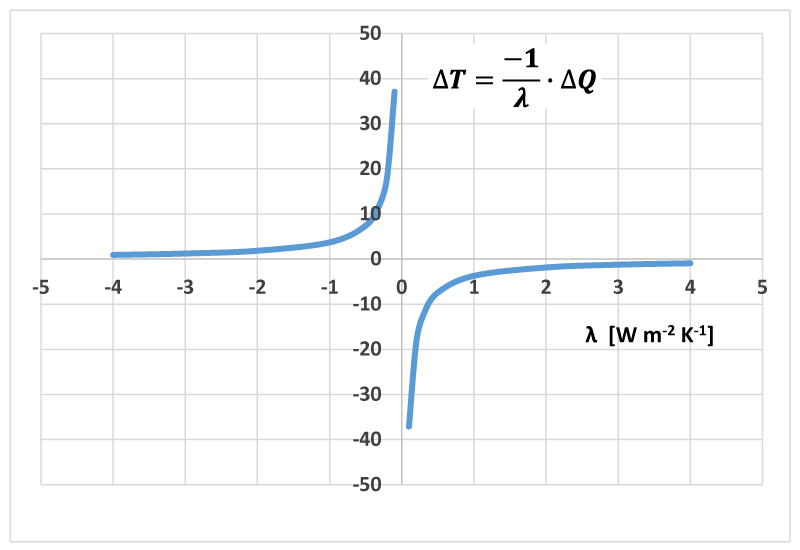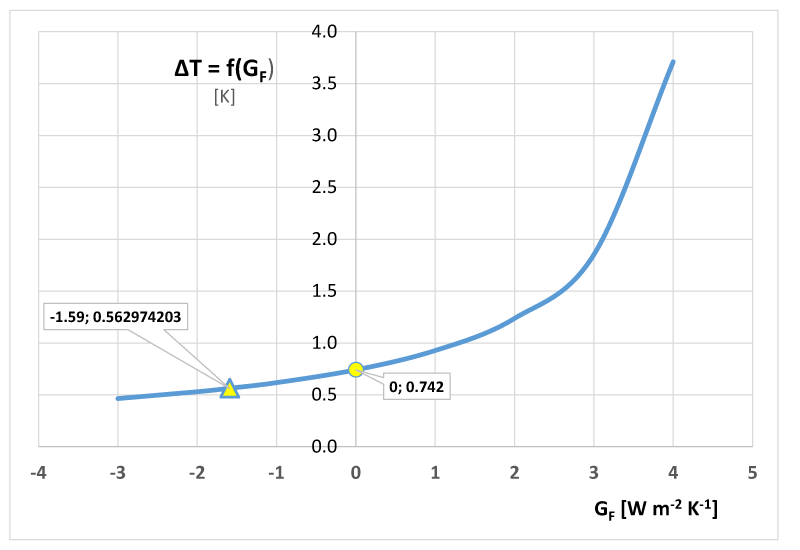Why is it that, since 2001 and insisting, IPCC continues to tell that the so-called Equilibrium Climate Sensitivity (ECS) is in the likely range of 1.5 to 4.5 °C?
This is based on a relatively old, but still in used, lecture by one of the most famous climate modelling expert. I intend here to debunk it.
It’s technical, therefore difficult to approach, but very important. So please, hang on, it's worth it!
ECS is a major factor used to ascribe warming to CO2. It is defined as the temperature increase that would result from a doubling of the CO2 atmospheric concentration.
With 400 ppm today and having started at the beginning of the industrial era (BIE) at 280 ppm we are not yet at doubling. To reach it, another 510 petagram of carbon should be farted away in addition to the 385 Pg already emitted since BIE, and we emit approx. 10 Pg every year (source: CDIAC).
Origin of the ominous 1.5 to 4.5 °C range.
In his lecture notes, Prof T. Stocker[1] is writing about feedback (page 35):
∆Q is the forcing induced by the absorption of electromagnetic radiation in the long wave IR range by so-called greenhouse gases.
According to Myhre[2], for doubling CO2 concentration: ∆Q = 5.35· ln(2)= 3.71 W m-2.
With such interpretation, the system response as function of the feedback factor λ is hyperbolic, as on the following diagram:

This is obviously wrong since a system with no feedback (λ=0) would have infinite and undetermined consequences, and a large positive feedback would be less problematic than a slight one!
Despite of presenting negative feedback factors λ as stabilizing components (cooling), Prof Stocker uses this ill-fated analysis to calculate the ECS.
With an overall λ = -1.3 W m-2 K-1 and a forcing for doubling CO2 of ΔQ= 3.71 W m-2 he finds (on page 42, eq 2.32):

Amazingly, this value is right in the midst of the IPCC alleged range of 1.5 to 4.5 K.
On table 9.5 of the latest IPCC report WG1 AR5, 31 models provide feedback factors, the average being
λ = -1.59 W m-2 K-1 with a 90% certainty range of ±1.85, thus making λ = 0 possible.
With such range, he could calculate any value for ΔT, up to run away!
Correct feedback calculation.
In my own calculation, taking the same IPCC feedback factors, my estimate of ECS is 0.6 ± 0.2 °C.
This is quite a considerable difference, with important consequences.
To obtain this, and contrary to Prof Stocker, I used a standard feedback systeem (link):
|
|
|
|
In this diagram the variables are:
|
|
| Applying the transfer functions and resolving for ∆T: | |
| ∆T = GS· Fall | |
| FF = GF· ∆T | |
| Fall = FGHG + FF =FGHG + GF· ∆T | |
| ∆T/GS = FGHG + GF·∆T | |
| ∆T·(1- GF·GS)= GS· FGHG |  |
Here, FGHG is thus the same as the above ∆Q;
GS is the derivative of the Stefan-Boltzmann law:

Thus with GS= 0.200 K W-1 m2 (it stays almost constant in the range 286-290 K),
and with a primary FGHG=5.35· ln(2) = 3.71 W m-2, the temperature increase after feedback will be depending on GF (=λ) as shown in this diagram:

This is the classical view of a control system that can run away if feedback is too positive, but with -1.59 ±1.85 it is not the case here.
With this feedback factor: ΔT = 0.56 K (within range 0.44 to 0.78)
and with no feedback: ΔT = 0.74 K.
Where is the error in the Stocker lecture?
In lieu of a feedback model, he took a simple linear forwarding mechanism:

The error lies in setting up a balance equation (2.16 in his lecture notes) that is not representing a feedback mechanism, but just the addition of components wrongly taken as independent from each other.
But a feedback is the response of the system in correction (attenuation or amplification) of the primary cause, in this case ΔQ. It cannot be just linearly added to it; it has to be a loop (to feed back).
Good scientists may be bad control engineers.
If the Equilibrium Climate Sensitivity is somewhere between 0.4 and 0.8 °C in lieu
of 1.5 to 4.5 °C, anyone can imagine the consequence:
reducing drastically CO2 emissions will have a futile impact on warming,
or in a more positive way, continuing using fossil fuels is not putting the planet in danger.
Ad hominem comment (sorry, but this needs to be noted):
It would be a menial oversight to be easily corrected if this would not form the essential quantitation of the anthropogenic warming dogma since decades, perpetuated by a top gun of IPCC.
Prof T. Stocker, an expert on climate models, is a leader in IPCC’s committees since a long time, in particular acting as Working Group I Co-Chair at the time of publishing the 5th Assessment report in 2013.
His influence is therefore larger than mine; he enjoys an unchallenged authority over the climate community. This does not prevent him to perpetuate a gross mistake, talking about feedback when just adding interdepending phenomena.
When I asked him for a comment, a deafening silence was the answer.
How can one be so wrong for such a so long time? Too much consensus? Too much to lose? Or ironclad tribal discipline?
© November 5, 2014. Michel de Rougemont
[1] Stocker T., University of Bern, Switzerland, Lecture notes, “Einführung in die Klima Modellierung.“, 2008
http://www.climate.unibe.ch/~stocker/papers/stocker08EKM.pdf
[2] Myhre et al.
New estimates of radiative forcing due to well mixed greenhouse gases.
Geophysical Research Letters, Vol. 25, No.14, pages 2715-2718, July 15, 1998
http://folk.uio.no/gunnarmy/paper/myhre_grl98.pdf




